Abstract
This study was undertaken to determine the factors involved in the development of insulin-sensitivity at weaning. Glucose kinetics were studied in suckling rats and in rats weaned on to a high-carbohydrate (HC) or a high-fat (HF) diet, in the basal state and during euglycaemic-hyperinsulinaemic-clamp studies. These studies were coupled with the 2-deoxyglucose technique, allowing a measure of glucose utilization by individual tissues. In the basal state, the glycaemia was higher in HF-weaned rats (124 +/- 4 mg/dl) than in suckling (109 +/- 1 mg/dl) and HC-weaned rats (101 +/- 3 mg/dl). Glucose turnover rates were similar in the three groups of animals (14 mg/min per kg). Nevertheless, basal metabolic glucose clearance rate was 20% lower in HF-weaned rats than in the other groups. During the euglycaemic-hyperinsulinaemic experiments, hepatic glucose production was suppressed by 90% in HC-weaned rats, whereas it remained at 40% of basal value in suckling and HF-weaned rats, indicating an insulin resistance of liver of these animals. Glucose clearance rate during the clamp was 18.3 +/- 0.9 ml/min per kg in suckling rats, whereas it was 35.3 +/- 1.2 ml/min per kg in HC-weaned rats and 27.8 +/- 1.1 ml/min per kg in HF-weaned rats, indicating an insulin resistance of glucose utilization in suckling, and to a lower extent, in HF-weaned rats. The deoxyglucose technique showed that peripheral insulin resistance was localized in muscles and white adipose tissue of suckling and HF-weaned rats. These results indicate that the switch from milk to a HC diet is an important determinant of the development of insulin-sensitivity at weaning in the rat.
Full text
PDF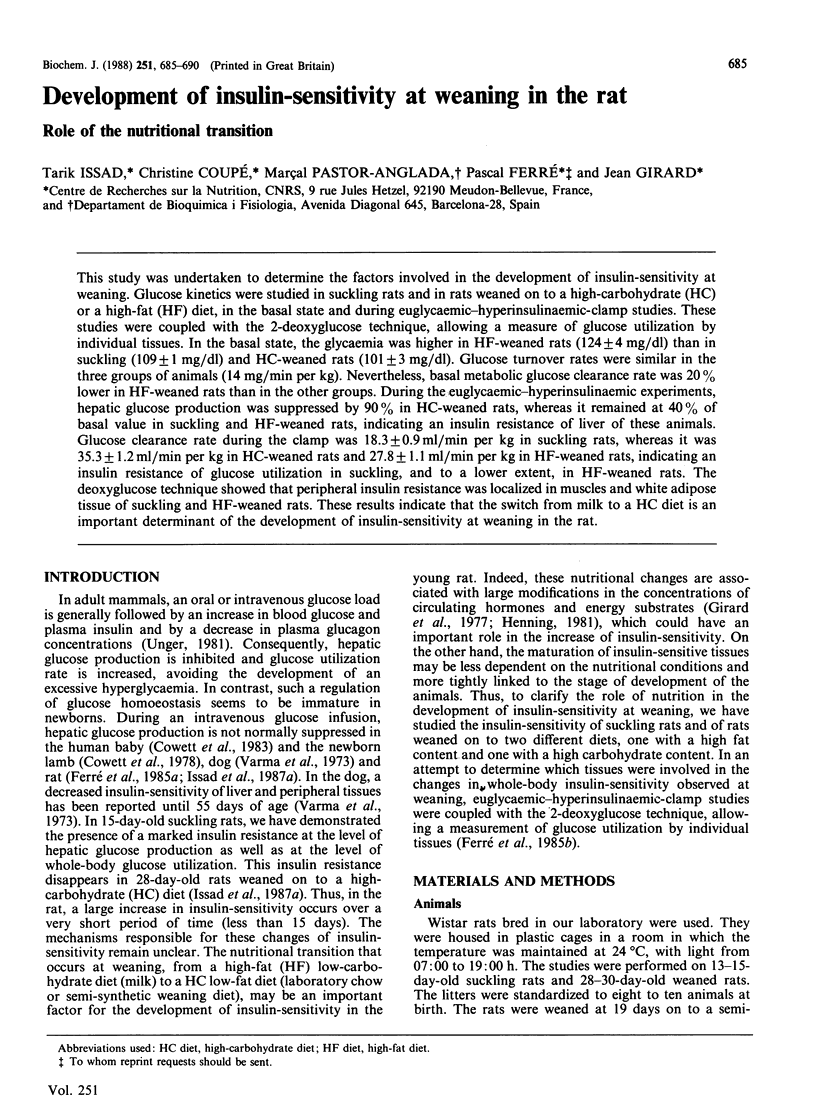
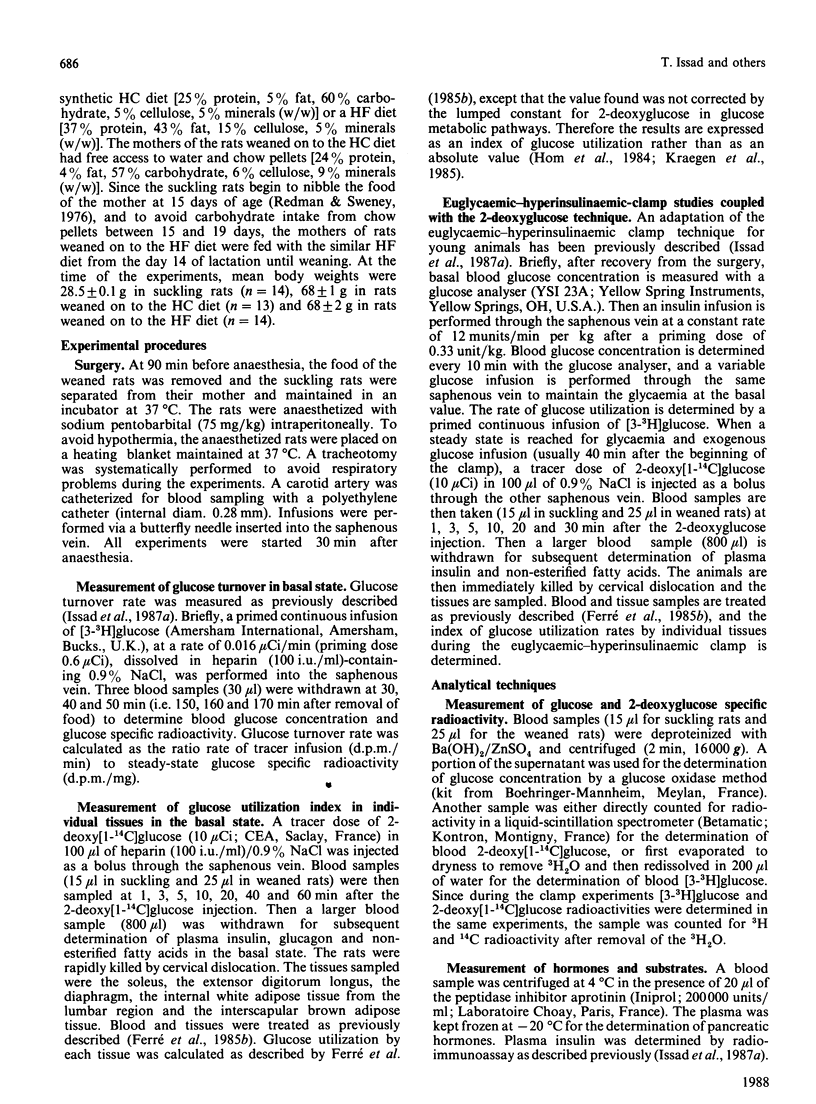
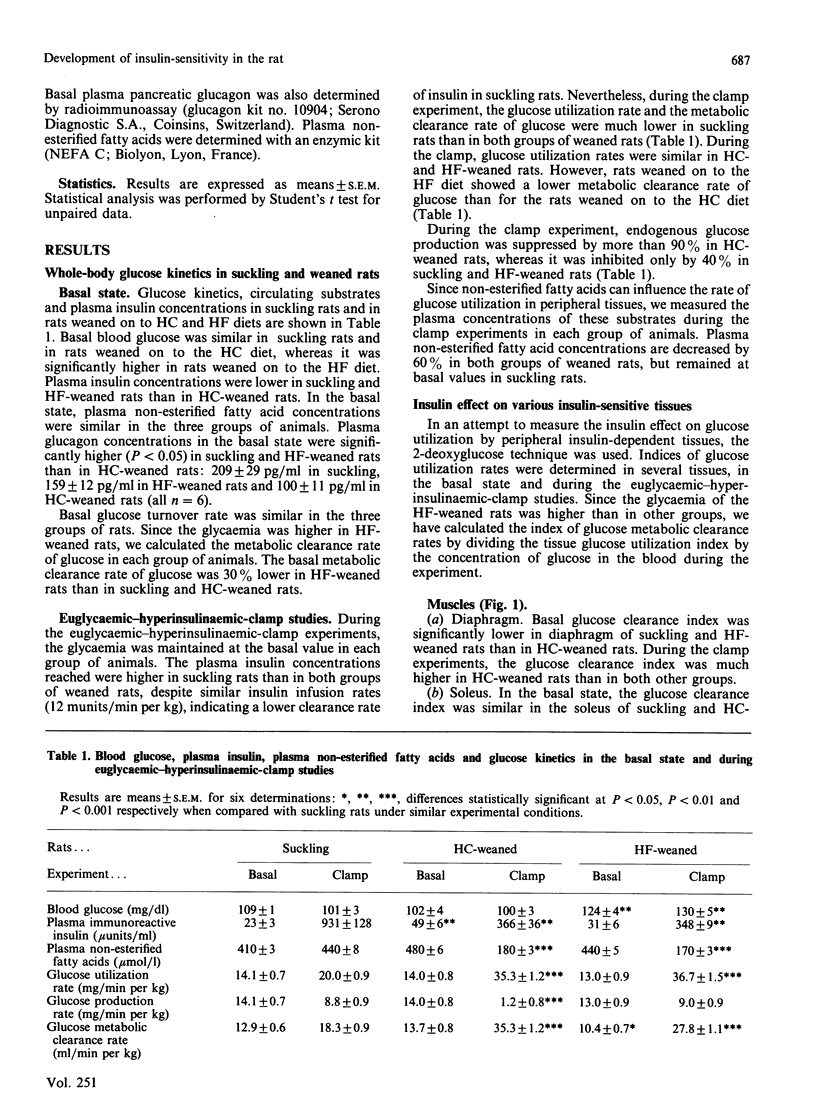
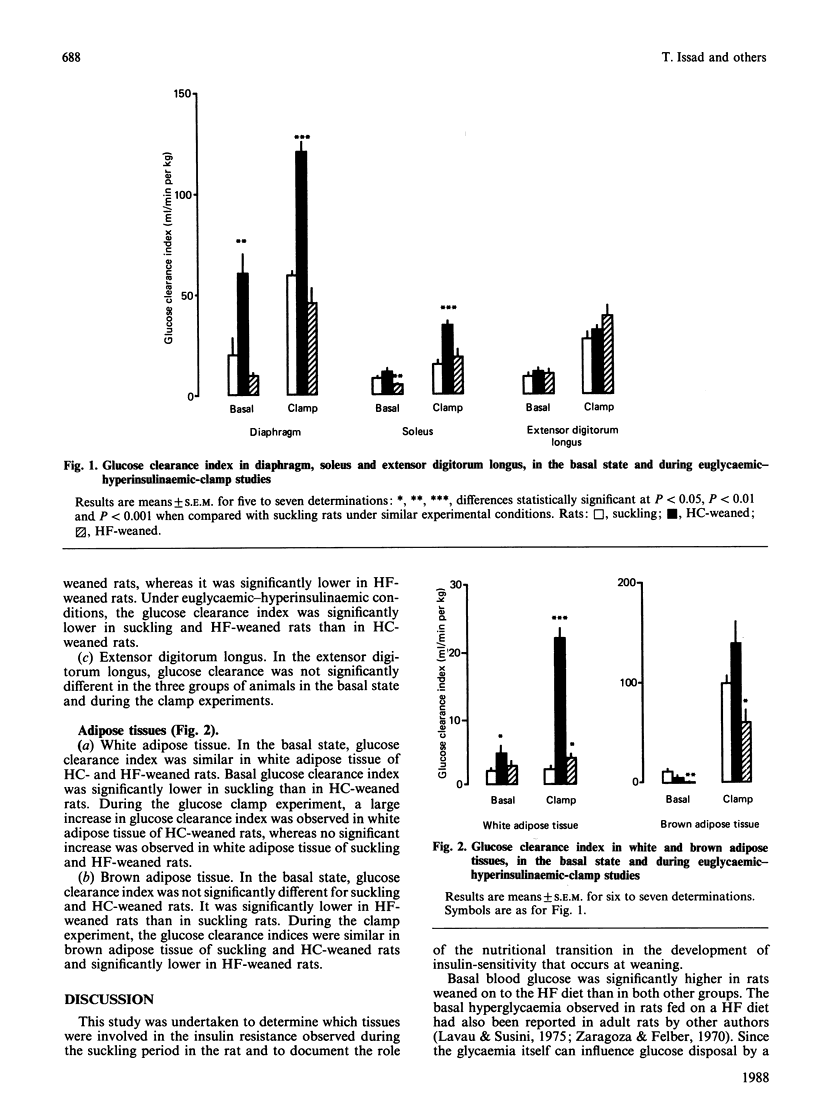
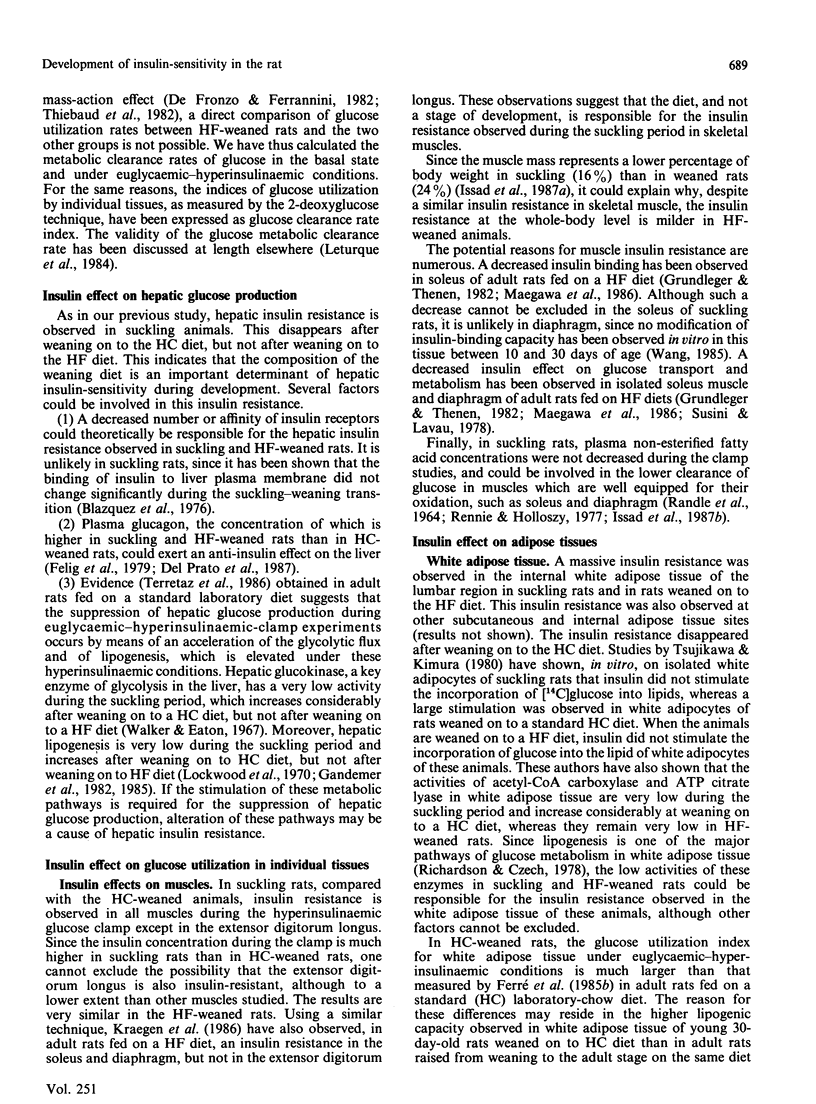
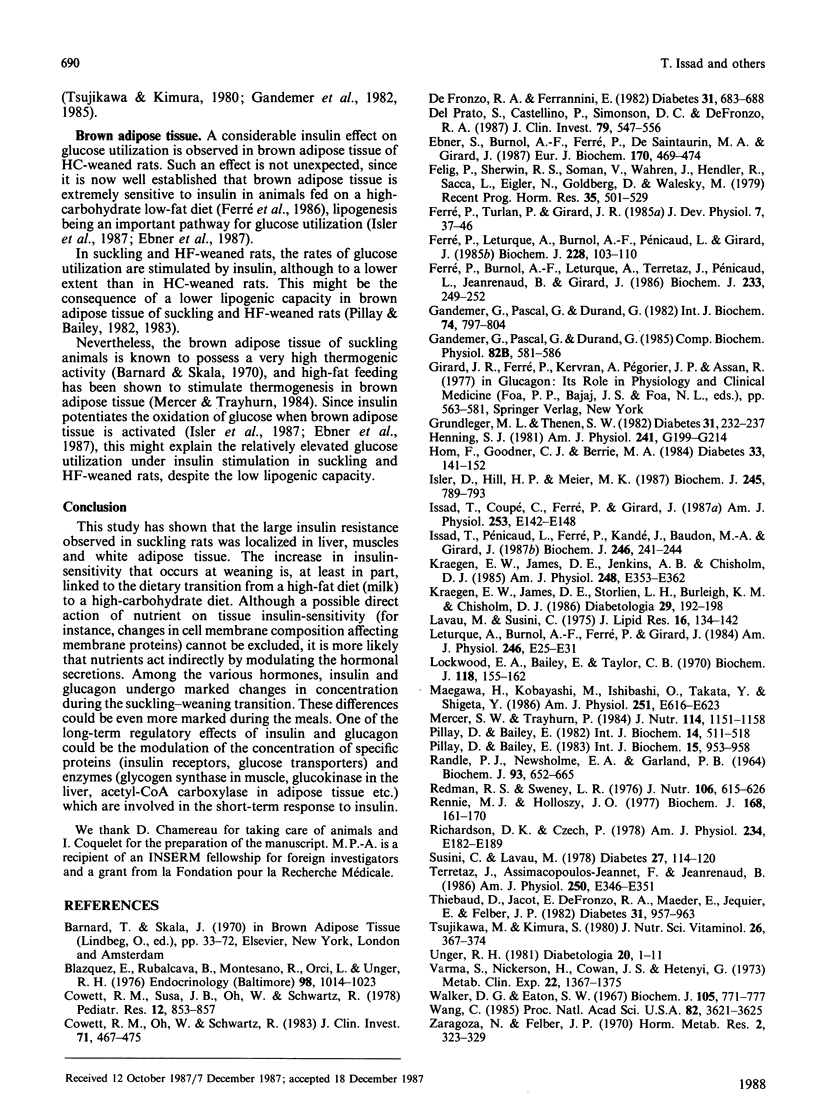
Selected References
These references are in PubMed. This may not be the complete list of references from this article.
- Blazquez E., Rubalcava B., Montesano R., Orci L., Unger R. H. Development of insulin and glucagon binding and the adenylate cyclase response in liver membranes of the prenatal, postnatal, and adult rat: evidence of glucagon "resistance". Endocrinology. 1976 Apr;98(4):1014–1023. doi: 10.1210/endo-98-4-1014. [DOI] [PubMed] [Google Scholar]
- Cowett R. M., Oh W., Schwartz R. Persistent glucose production during glucose infusion in the neonate. J Clin Invest. 1983 Mar;71(3):467–475. doi: 10.1172/JCI110791. [DOI] [PMC free article] [PubMed] [Google Scholar]
- Cowett R. M., Susa J. B., Oh W., Schwartz R. Endogenous glucose production during constant glucose infusion in the newborn lamb. Pediatr Res. 1978 Aug;12(8):853–857. doi: 10.1203/00006450-197808000-00010. [DOI] [PubMed] [Google Scholar]
- DeFronzo R. A., Ferrannini E. Influence of plasma glucose and insulin concentration on plasma glucose clearance in man. Diabetes. 1982 Aug;31(8 Pt 1):683–688. doi: 10.2337/diab.31.8.683. [DOI] [PubMed] [Google Scholar]
- Del Prato S., Castellino P., Simonson D. C., DeFronzo R. A. Hyperglucagonemia and insulin-mediated glucose metabolism. J Clin Invest. 1987 Feb;79(2):547–556. doi: 10.1172/JCI112846. [DOI] [PMC free article] [PubMed] [Google Scholar]
- Ebner S., Burnol A. F., Ferre P., de Saintaurin M. A., Girard J. Effects of insulin and norepinephrine on glucose transport and metabolism in rat brown adipocytes. Potentiation by insulin of norepinephrine-induced glucose oxidation. Eur J Biochem. 1987 Dec 30;170(1-2):469–474. doi: 10.1111/j.1432-1033.1987.tb13723.x. [DOI] [PubMed] [Google Scholar]
- Felig P., Sherwin R. S., Soman V., Wahren J., Hendler R., Sacca L., Eigler N., Goldberg D., Walesky M. Hormonal interactions in the regulation of blood glucose. Recent Prog Horm Res. 1979;35:501–532. doi: 10.1016/b978-0-12-571135-7.50016-3. [DOI] [PubMed] [Google Scholar]
- Ferré P., Burnol A. F., Leturque A., Terretaz J., Penicaud L., Jeanrenaud B., Girard J. Glucose utilization in vivo and insulin-sensitivity of rat brown adipose tissue in various physiological and pathological conditions. Biochem J. 1986 Jan 1;233(1):249–252. doi: 10.1042/bj2330249. [DOI] [PMC free article] [PubMed] [Google Scholar]
- Ferré P., Leturque A., Burnol A. F., Penicaud L., Girard J. A method to quantify glucose utilization in vivo in skeletal muscle and white adipose tissue of the anaesthetized rat. Biochem J. 1985 May 15;228(1):103–110. doi: 10.1042/bj2280103. [DOI] [PMC free article] [PubMed] [Google Scholar]
- Ferré P., Turlan P., Girard J. Effects of medium-chain triglyceride feeding or glucose infusion on glucose kinetics in the newborn rat. J Dev Physiol. 1985 Feb;7(1):37–46. [PubMed] [Google Scholar]
- Gandemer G., Pascal G., Durand G. Comparative changes in the lipogenic enzyme activities and in the in vivo fatty acid synthesis in liver and adipose tissues during the post-weaning growth of male rats. Comp Biochem Physiol B. 1985;82(4):581–586. doi: 10.1016/0305-0491(85)90493-6. [DOI] [PubMed] [Google Scholar]
- Grundleger M. L., Thenen S. W. Decreased insulin binding, glucose transport, and glucose metabolism in soleus muscle of rats fed a high fat diet. Diabetes. 1982 Mar;31(3):232–237. doi: 10.2337/diab.31.3.232. [DOI] [PubMed] [Google Scholar]
- Henning S. J. Postnatal development: coordination of feeding, digestion, and metabolism. Am J Physiol. 1981 Sep;241(3):G199–G214. doi: 10.1152/ajpgi.1981.241.3.G199. [DOI] [PubMed] [Google Scholar]
- Hom F. G., Goodner C. J., Berrie M. A. A [3H]2-deoxyglucose method for comparing rates of glucose metabolism and insulin responses among rat tissues in vivo. Validation of the model and the absence of an insulin effect on brain. Diabetes. 1984 Feb;33(2):141–152. doi: 10.2337/diab.33.2.141. [DOI] [PubMed] [Google Scholar]
- Isler D., Hill H. P., Meier M. K. Glucose metabolism in isolated brown adipocytes under beta-adrenergic stimulation. Quantitative contribution of glucose to total thermogenesis. Biochem J. 1987 Aug 1;245(3):789–793. doi: 10.1042/bj2450789. [DOI] [PMC free article] [PubMed] [Google Scholar]
- Issad T., Coupe C., Ferre P., Girard J. Insulin resistance during suckling period in rats. Am J Physiol. 1987 Aug;253(2 Pt 1):E142–E148. doi: 10.1152/ajpendo.1987.253.2.E142. [DOI] [PubMed] [Google Scholar]
- Issad T., Pénicaud L., Ferré P., Kandé J., Baudon M. A., Girard J. Effects of fasting on tissue glucose utilization in conscious resting rats. Major glucose-sparing effect in working muscles. Biochem J. 1987 Aug 15;246(1):241–244. doi: 10.1042/bj2460241. [DOI] [PMC free article] [PubMed] [Google Scholar]
- Kraegen E. W., James D. E., Jenkins A. B., Chisholm D. J. Dose-response curves for in vivo insulin sensitivity in individual tissues in rats. Am J Physiol. 1985 Mar;248(3 Pt 1):E353–E362. doi: 10.1152/ajpendo.1985.248.3.E353. [DOI] [PubMed] [Google Scholar]
- Kraegen E. W., James D. E., Storlien L. H., Burleigh K. M., Chisholm D. J. In vivo insulin resistance in individual peripheral tissues of the high fat fed rat: assessment by euglycaemic clamp plus deoxyglucose administration. Diabetologia. 1986 Mar;29(3):192–198. doi: 10.1007/BF02427092. [DOI] [PubMed] [Google Scholar]
- Lavau M., Susini C. [U-14C]glucose metabolism in vivo in rats rendered obese by a high fat diet. J Lipid Res. 1975 Mar;16(2):134–142. [PubMed] [Google Scholar]
- Leturque A., Burnol A. F., Ferré P., Girard J. Pregnancy-induced insulin resistance in the rat: assessment by glucose clamp technique. Am J Physiol. 1984 Jan;246(1 Pt 1):E25–E31. doi: 10.1152/ajpendo.1984.246.1.E25. [DOI] [PubMed] [Google Scholar]
- Lockwood E. A., Bailey E., Taylor C. B. Factors involved in changes in hepatic lipogenesis during development of the rat. Biochem J. 1970 Jun;118(1):155–162. doi: 10.1042/bj1180155. [DOI] [PMC free article] [PubMed] [Google Scholar]
- Maegawa H., Kobayashi M., Ishibashi O., Takata Y., Shigeta Y. Effect of diet change on insulin action: difference between muscles and adipocytes. Am J Physiol. 1986 Nov;251(5 Pt 1):E616–E623. doi: 10.1152/ajpendo.1986.251.5.E616. [DOI] [PubMed] [Google Scholar]
- Mercer S. W., Trayhurn P. Effect of high fat diets on the thermogenic activity of brown adipose tissue in cold-acclimated mice. J Nutr. 1984 Jun;114(6):1151–1158. doi: 10.1093/jn/114.6.1151. [DOI] [PubMed] [Google Scholar]
- Pillay D., Bailey E. Perinatal lipogenesis in the liver and brown adipose tissue of the rat. Int J Biochem. 1982;14(6):511–517. doi: 10.1016/0020-711x(82)90119-7. [DOI] [PubMed] [Google Scholar]
- Pillay D., Bailey E. Triiodothyronine-dietary interrelationships in the modulation of brown adipose tissue and liver lipogenesis in the rat. Int J Biochem. 1983;15(7):953–958. doi: 10.1016/0020-711x(83)90173-8. [DOI] [PubMed] [Google Scholar]
- Randle P. J., Newsholme E. A., Garland P. B. Regulation of glucose uptake by muscle. 8. Effects of fatty acids, ketone bodies and pyruvate, and of alloxan-diabetes and starvation, on the uptake and metabolic fate of glucose in rat heart and diaphragm muscles. Biochem J. 1964 Dec;93(3):652–665. doi: 10.1042/bj0930652. [DOI] [PMC free article] [PubMed] [Google Scholar]
- Redman R. S., Sweney L. R. Changes in diet and patterns of feeding activity of developing rats. J Nutr. 1976 May;106(5):615–626. doi: 10.1093/jn/106.5.615. [DOI] [PubMed] [Google Scholar]
- Rennie M. J., Holloszy J. O. Inhibition of glucose uptake and glycogenolysis by availability of oleate in well-oxygenated perfused skeletal muscle. Biochem J. 1977 Nov 15;168(2):161–170. doi: 10.1042/bj1680161. [DOI] [PMC free article] [PubMed] [Google Scholar]
- Richardson D. K., Czech M. P. Primary role of decreased fatty acid synthesis in insulin resistance of large rat adipocytes. Am J Physiol. 1978 Feb;234(2):E182–E189. doi: 10.1152/ajpendo.1978.234.2.E182. [DOI] [PubMed] [Google Scholar]
- Susini C., Lavau M. In-vitro and in-vivo responsiveness of muscle and adipose tissue to insulin in rats rendered obese by a high-fat diet. Diabetes. 1978 Feb;27(2):114–120. doi: 10.2337/diab.27.2.114. [DOI] [PubMed] [Google Scholar]
- Terrettaz J., Assimacopoulos-Jeannet F., Jeanrenaud B. Inhibition of hepatic glucose production by insulin in vivo in rats: contribution of glycolysis. Am J Physiol. 1986 Apr;250(4 Pt 1):E346–E351. doi: 10.1152/ajpendo.1986.250.4.E346. [DOI] [PubMed] [Google Scholar]
- Thiebaud D., Jacot E., DeFronzo R. A., Maeder E., Jequier E., Felber J. P. The effect of graded doses of insulin on total glucose uptake, glucose oxidation, and glucose storage in man. Diabetes. 1982 Nov;31(11):957–963. doi: 10.2337/diacare.31.11.957. [DOI] [PubMed] [Google Scholar]
- Tsujikawa M., Kimura S. Changes in lipid synthesis in rat adipose tissue during development. J Nutr Sci Vitaminol (Tokyo) 1980;26(4):367–374. doi: 10.3177/jnsv.26.367. [DOI] [PubMed] [Google Scholar]
- Unger R. H. The milieu interieur and the islets of Langerhans. Diabetologia. 1981;20(1):1–11. doi: 10.1007/BF00253809. [DOI] [PubMed] [Google Scholar]
- Varma S., Nickerson H., Cowan J. S., Hetenyi G., Jr Homeostatic responses to glucose loading in newborn and young dogs. Metabolism. 1973 Nov;23(2):1367–1375. doi: 10.1016/0026-0495(73)90252-7. [DOI] [PubMed] [Google Scholar]
- Walker D. G., Eaton S. W. Regulation of development of hepatic glucokinase in the neonatal rat by the diet. Biochem J. 1967 Nov;105(2):771–777. doi: 10.1042/bj1050771. [DOI] [PMC free article] [PubMed] [Google Scholar]
- Wang C. Insulin-stimulated glucose uptake in rat diaphragm during postnatal development: lack of correlation with the number of insulin receptors and of intracellular glucose transporters. Proc Natl Acad Sci U S A. 1985 Jun;82(11):3621–3625. doi: 10.1073/pnas.82.11.3621. [DOI] [PMC free article] [PubMed] [Google Scholar]
- Zaragoza N., Felber J. P. Studies on the metabolic effects induced in the rat by a high fat diet. I. Carbohydrate metabolism in vivo. Horm Metab Res. 1970 Nov;2(6):323–329. doi: 10.1055/s-0028-1095057. [DOI] [PubMed] [Google Scholar]


